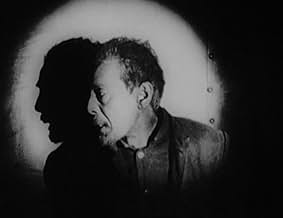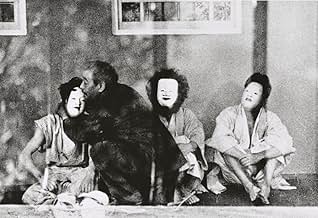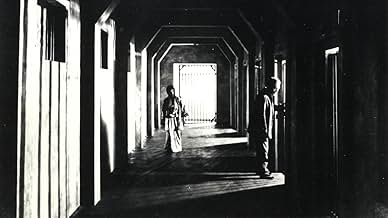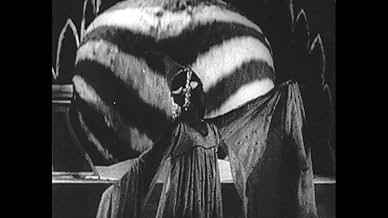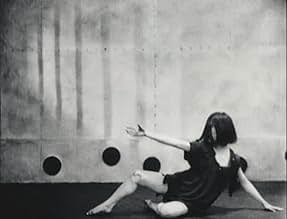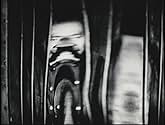IMDb-BEWERTUNG
7,3/10
5017
IHRE BEWERTUNG
Füge eine Handlung in deiner Sprache hinzuA man takes a job at an asylum with hopes of freeing his imprisoned wife.A man takes a job at an asylum with hopes of freeing his imprisoned wife.A man takes a job at an asylum with hopes of freeing his imprisoned wife.
Empfohlene Bewertungen
10mjneu59
Film history has been negligent in recognizing this landmark silent drama, made in 1926 by pioneering Japanese director Teinosuke Kinugasa, but unknown until 1971, when a surviving print was (literally) unearthed in the director's garden shed. The film was produced in an isolated creative environment far removed from any foreign influence, but is nevertheless a masterpiece of imagery and editing, revealing a stunning visual flair and employing montage techniques as skillfully as anyone since Eisenstein. It tells a powerful, hallucinatory story of a janitor in an insane asylum who wants desperately to help his inmate wife after she attempts suicide, and like Murnau's 'The Last Laugh' unfolds without the crutch of intertitles. The film has aged remarkable little after the better part of a century in limbo, but since its belated rediscovery has yet to earn the acclaim and evaluation it deserves.
Kurutta Ippeji offers a view on the distorted perspective of a troubled janitor in a mental asylum. As a proof of concept, it shows that experimental cinematic techniques can affect the way narration is perceived by the viewer - here, the visual elements contribute to how the viewer experiences the characters' mental state. As an experiment, the movie possibly even makes a stronger case than the comparably surreal Hausu (1977), which is partly imbalanced in its style. However, due to the poor visual quality and the lack of functional storytelling, this experimental feature can't be easily recommended to people looking for a more conventional feature.
Overall 7/10
Full Review on movie-discouse.blogspot.com
10quinolas
An old man works as a janitor in a mental hospital to be close to his wife who is a patient there and to try to get her out.
This is surely one of the most forgotten masterpieces of the silent era and an oddity in the history of Japanese cinema. Long thought lost, a print was found in the 70s and a music soundtrack added to it, which fits perfectly with the images. It might have been influenced by cabinet of doctor Caligary (director Kinugasa claimed he never saw the German film). However it surpasses it in style and in its more convincing (and chilly) portray of the inner mental state of the inmates in the asylum. To achieve this, the film makes use of every single film technique available at the time: multiple exposures and out of focus subjective point of view, tilted camera angles, fast and slow motion, expressionist lighting and superimpositions among others. It is also a very complicated film to follow, as it has not got intertitles.
The film opens with a montage of shots of rain hitting the windows of the hospital, wind shaking trees and of thunder. The unsettling weather metaphors the mental condition of the patients and introduces one of the them: a former dancer. The combination of sounds produced by rain, wind and thunder serves as the music that incites the dancer to get into a frantic, almost hypnotic dance. In another sequence involving the same patient engaged in another frenzied dance, she is being watched by other inmates. Multiple exposures of the dancer represent the patients' point of view and their confused "view" of the world.
These are just two examples from this amazing film trying to represent the patients' subconscious and view of the "sane" world.
In three words A MUST SEE.
This is surely one of the most forgotten masterpieces of the silent era and an oddity in the history of Japanese cinema. Long thought lost, a print was found in the 70s and a music soundtrack added to it, which fits perfectly with the images. It might have been influenced by cabinet of doctor Caligary (director Kinugasa claimed he never saw the German film). However it surpasses it in style and in its more convincing (and chilly) portray of the inner mental state of the inmates in the asylum. To achieve this, the film makes use of every single film technique available at the time: multiple exposures and out of focus subjective point of view, tilted camera angles, fast and slow motion, expressionist lighting and superimpositions among others. It is also a very complicated film to follow, as it has not got intertitles.
The film opens with a montage of shots of rain hitting the windows of the hospital, wind shaking trees and of thunder. The unsettling weather metaphors the mental condition of the patients and introduces one of the them: a former dancer. The combination of sounds produced by rain, wind and thunder serves as the music that incites the dancer to get into a frantic, almost hypnotic dance. In another sequence involving the same patient engaged in another frenzied dance, she is being watched by other inmates. Multiple exposures of the dancer represent the patients' point of view and their confused "view" of the world.
These are just two examples from this amazing film trying to represent the patients' subconscious and view of the "sane" world.
In three words A MUST SEE.
This is actually one of the titles of the film, a page out of order. It perfectly reflects the film itself, a narrative fractured, demented, cast in and out of a feverish mind, but ultimately incomplete to us, and the various misconceptions it has spawned in trying to evaluate as though it was the whole thing.
I was increasingly suspicious of this while watching, that I was basically confronted with an incomplete film and so a film impenetrable not wholly by design but only because the keys have been lost to us, or are not attached to the film we are watching and we have to apprehend elsewhere. Doing a little research afterwards only confirmed my doubts. So a little context:
-the film is not the tip of the iceberg of an advanced cinema whose main body is lamentably lost to us; it was saved exactly because it was an exception, a low-budget oddity the filmmaker himself re-discovered in his garden shed. The majority of silent Japanese cinema - whose final traces were eclipsed in the aftermath of WWII - were generic studio reworkings of popular material.
-it is not the product of an 'isolated cinematic environment free of influence', rather a studied attempt to recreate what the French avant-garde was pioneering at the time; so yes, the superimpositions, the haze of motions and details, the rapid-fire montage, all of them tools in the attempt to offer us a glimpse of the fractured, elusive reality of the mind, available tools at the time that Kinugasa knew from other films.
-so even though the idea of a janitor coming to work in a mental hospital may carry hues of Caligari, the film itself is from the line of what in France was called impressionism; the films of Epstein, L'Herbier, Gance.
-most importantly, even though the closest parable I can think of is Menilmontant, another French film from the same year that in place of story tried to paint with only images a state of mind from inside the mirror, that film was directly structured around images. It was intended to be seen as we have it. Watching Page it becomes increasingly obvious that a story deeply pertains to what we see; as was customary in Japan at the time, that story was meant to be narrated to the audience by a benshi, a narrator supplied by each theater. We may cobble together a view of that story from other sources, but the intended effect is lost to us.
-there is still the problem that in the version we have approximately one third of the film is missing. Most of it in the end from what I can tell, where the girl is supposed to marry her fiancé (which echoes and wonderfully annotates the scene where the janitor imagines himself reunited with his wife.
Oh, what we have of the film is more than fine, it's actually one of the most captivating visions of the mind in disarray from the time. But it was just not meant to be seen as merely a tone poem. The dreamy flow is clearly flowing somewhere. What we have instead is only what was salvaged from it but at the same time near complete enough, making barely enough sense to stand on its own, that we may be inclined to accept as the full vision.
We can still accept this itself as a fragment of madness and interpret from where our imagination takes us. That is fine, I encourage this.
Rumors have been circulating about a new restored version, hopefully one that - next to a better print - somehow includes the narration, preferably by a benshi, or intertitles at the very least. Until then, no rating from me.
I was increasingly suspicious of this while watching, that I was basically confronted with an incomplete film and so a film impenetrable not wholly by design but only because the keys have been lost to us, or are not attached to the film we are watching and we have to apprehend elsewhere. Doing a little research afterwards only confirmed my doubts. So a little context:
-the film is not the tip of the iceberg of an advanced cinema whose main body is lamentably lost to us; it was saved exactly because it was an exception, a low-budget oddity the filmmaker himself re-discovered in his garden shed. The majority of silent Japanese cinema - whose final traces were eclipsed in the aftermath of WWII - were generic studio reworkings of popular material.
-it is not the product of an 'isolated cinematic environment free of influence', rather a studied attempt to recreate what the French avant-garde was pioneering at the time; so yes, the superimpositions, the haze of motions and details, the rapid-fire montage, all of them tools in the attempt to offer us a glimpse of the fractured, elusive reality of the mind, available tools at the time that Kinugasa knew from other films.
-so even though the idea of a janitor coming to work in a mental hospital may carry hues of Caligari, the film itself is from the line of what in France was called impressionism; the films of Epstein, L'Herbier, Gance.
-most importantly, even though the closest parable I can think of is Menilmontant, another French film from the same year that in place of story tried to paint with only images a state of mind from inside the mirror, that film was directly structured around images. It was intended to be seen as we have it. Watching Page it becomes increasingly obvious that a story deeply pertains to what we see; as was customary in Japan at the time, that story was meant to be narrated to the audience by a benshi, a narrator supplied by each theater. We may cobble together a view of that story from other sources, but the intended effect is lost to us.
-there is still the problem that in the version we have approximately one third of the film is missing. Most of it in the end from what I can tell, where the girl is supposed to marry her fiancé (which echoes and wonderfully annotates the scene where the janitor imagines himself reunited with his wife.
Oh, what we have of the film is more than fine, it's actually one of the most captivating visions of the mind in disarray from the time. But it was just not meant to be seen as merely a tone poem. The dreamy flow is clearly flowing somewhere. What we have instead is only what was salvaged from it but at the same time near complete enough, making barely enough sense to stand on its own, that we may be inclined to accept as the full vision.
We can still accept this itself as a fragment of madness and interpret from where our imagination takes us. That is fine, I encourage this.
Rumors have been circulating about a new restored version, hopefully one that - next to a better print - somehow includes the narration, preferably by a benshi, or intertitles at the very least. Until then, no rating from me.
A Page of Madness is an expressionistic Japanese film that has not gotten the attention it deserves. I was introduced to the film through the fifteen part documentary series The Story of Film an Odyssey. Fortunately, a friend had dubbed the silent film off of Turner Classic Movies during one of its infrequent showings.
The clip in The Story of a Film an Odyssey looked like some mad movie genius had crossed the set designs from a German expressionist film with the fast edits of a classic Russian work. This clip was from the attention grabbing opening of A Page of Madness. A janitor wanders an insane asylum at night during a storm. The storm has a strange effect on the patients and, presumably, the attendant. The edits are fast, conveying mystery and terror like in a horror film. This sequence (and a sequence at the climax) is nothing short of brilliance.
From here the film turns to a narrative, although an oblique one. This clerk or janitor seems to have an unhealthy fixation on one of the female patients. . . and more of one for this patient's daughter. The janitor clearly knew this family before the mother was committed. IMDb says that the woman is the janitor's wife. I am not doubting this, but the film is not clear on this point. What is clear is that the janitor is suffering from a lack of love. This janitor is not the only one. One patient is compelled to dance suggestively and nearly starts a riot. By contrast, the doctors appear clinical and ineffectual. As the film goes along, the protagonist's mental state seems to wane.
Much about the plot is unclear. Many Japanese silent were narrated by a spokesman in the theater. This may have been the case with A Page of Madness; thus, some of the ambiguity would have been explained by the live narrator. I prefer to think the ambiguity was deliberate and never explained. The film has a wonderful sense of mystery to it. I don't want any more of an explanation. I (and probably most film fans) watch a lot of movies that are merely fair. These films are watchable, but they do not stay in one's memory. That is why A Page of Madness is so stunning. It kicks the door down and announces itself to the world. I feel less like a reviewer than a herald for a lost classic. Are you listening Criterion?
The clip in The Story of a Film an Odyssey looked like some mad movie genius had crossed the set designs from a German expressionist film with the fast edits of a classic Russian work. This clip was from the attention grabbing opening of A Page of Madness. A janitor wanders an insane asylum at night during a storm. The storm has a strange effect on the patients and, presumably, the attendant. The edits are fast, conveying mystery and terror like in a horror film. This sequence (and a sequence at the climax) is nothing short of brilliance.
From here the film turns to a narrative, although an oblique one. This clerk or janitor seems to have an unhealthy fixation on one of the female patients. . . and more of one for this patient's daughter. The janitor clearly knew this family before the mother was committed. IMDb says that the woman is the janitor's wife. I am not doubting this, but the film is not clear on this point. What is clear is that the janitor is suffering from a lack of love. This janitor is not the only one. One patient is compelled to dance suggestively and nearly starts a riot. By contrast, the doctors appear clinical and ineffectual. As the film goes along, the protagonist's mental state seems to wane.
Much about the plot is unclear. Many Japanese silent were narrated by a spokesman in the theater. This may have been the case with A Page of Madness; thus, some of the ambiguity would have been explained by the live narrator. I prefer to think the ambiguity was deliberate and never explained. The film has a wonderful sense of mystery to it. I don't want any more of an explanation. I (and probably most film fans) watch a lot of movies that are merely fair. These films are watchable, but they do not stay in one's memory. That is why A Page of Madness is so stunning. It kicks the door down and announces itself to the world. I feel less like a reviewer than a herald for a lost classic. Are you listening Criterion?
Wusstest du schon
- WissenswertesThis film was deemed lost for more than forty years, but it was rediscovered by its director, Teinosuke Kinugasa, in a rice cans in 1971.
- Alternative VersionenReissued in Japan in 1973 with musical score replacing original benshi.
- VerbindungenFeatured in The Story of Film: An Odyssey: The Golden Age of World Cinema (2011)
Top-Auswahl
Melde dich zum Bewerten an und greife auf die Watchlist für personalisierte Empfehlungen zu.
- How long is A Page of Madness?Powered by Alexa
Details
Box Office
- Budget
- 20.000 ¥ (geschätzt)
- Laufzeit1 Stunde 10 Minuten
- Farbe
- Sound-Mix
- Seitenverhältnis
- 1.33 : 1
Zu dieser Seite beitragen
Bearbeitung vorschlagen oder fehlenden Inhalt hinzufügen


